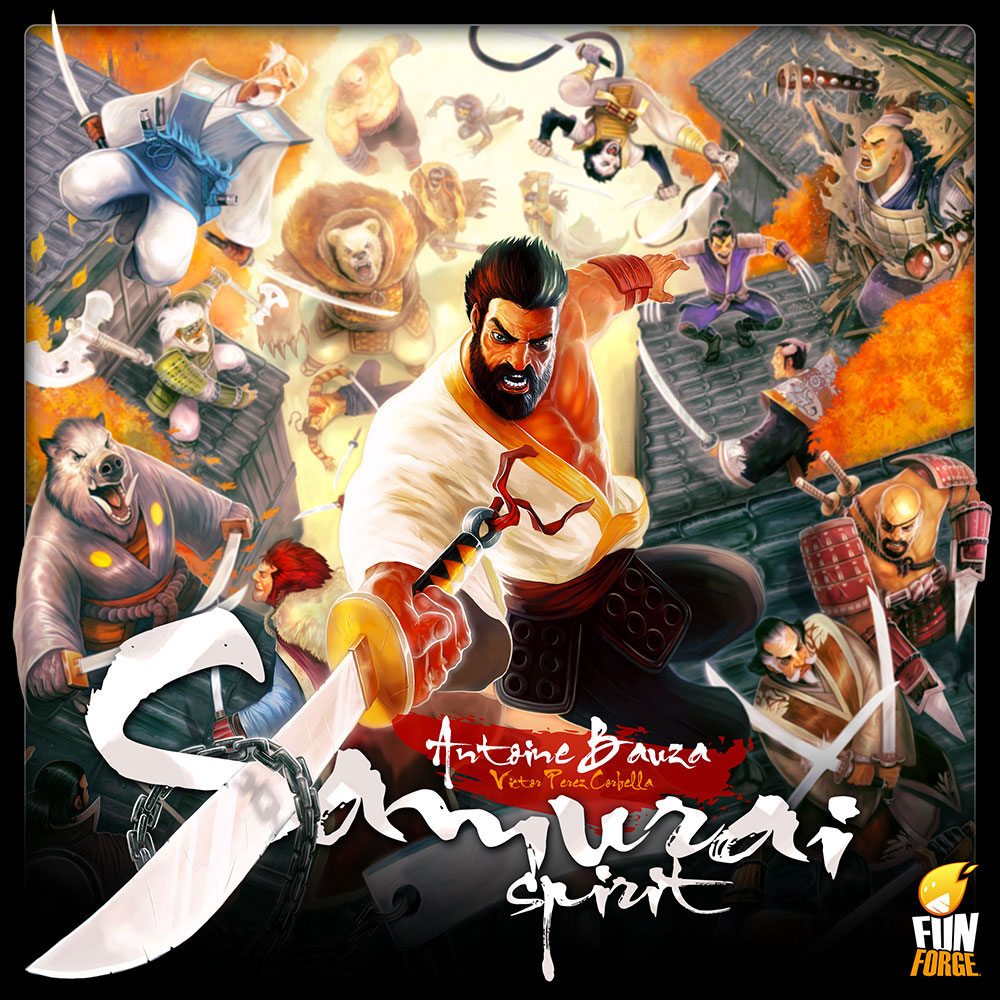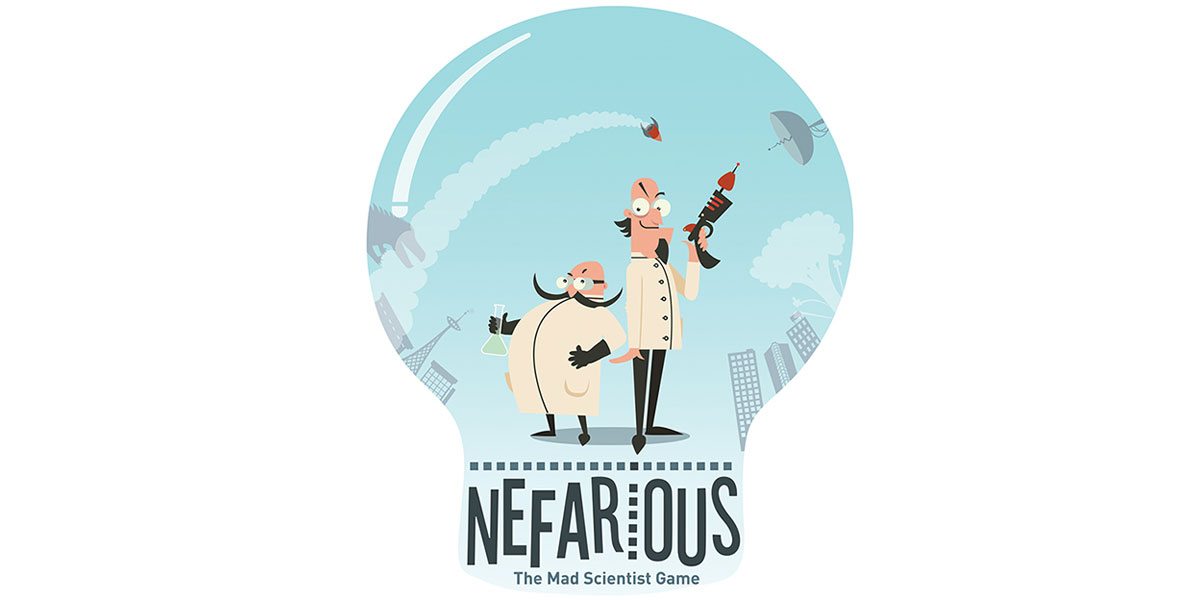The village is under attack from raiding bandits, with seven samurai as their only defense. You are few, but if things get desperate, each of you has the power to unleash your beastly Samurai Spirit.
At a glance: Samurai Spirit is a difficult cooperative game for 1 to 7 players, ages 10 and up, and takes 20-45 minutes to play. It retails for $29.99. Although the game’s theme is about enemies raiding a village, there isn’t much depicted of the violence itself (other than the cover) so the artwork is mostly kid-safe. However, winning is very challenging and I think age 10 and up is probably a pretty good benchmark.
Components:
- 7 Samurai game boards
- 7 Samurai meeples
- 7 support tokens
- 6 Farmstead tokens
- 10 Barricade tokens
- 3 Family tokens
- 66 Raider cards
- 1 Village board
- 1 Active Player marker
- 17 Wound markers

All of the components are a nice quality, nice cardboard tokens and good cards. I also like that the game is fairly compact: the board is small, and the box isn’t enormous. The plastic insert works well enough, but is a little odd–because the well for the samurai boards has slightly angled edges, the boards don’t fit flat in it, and instead rest at an angle.
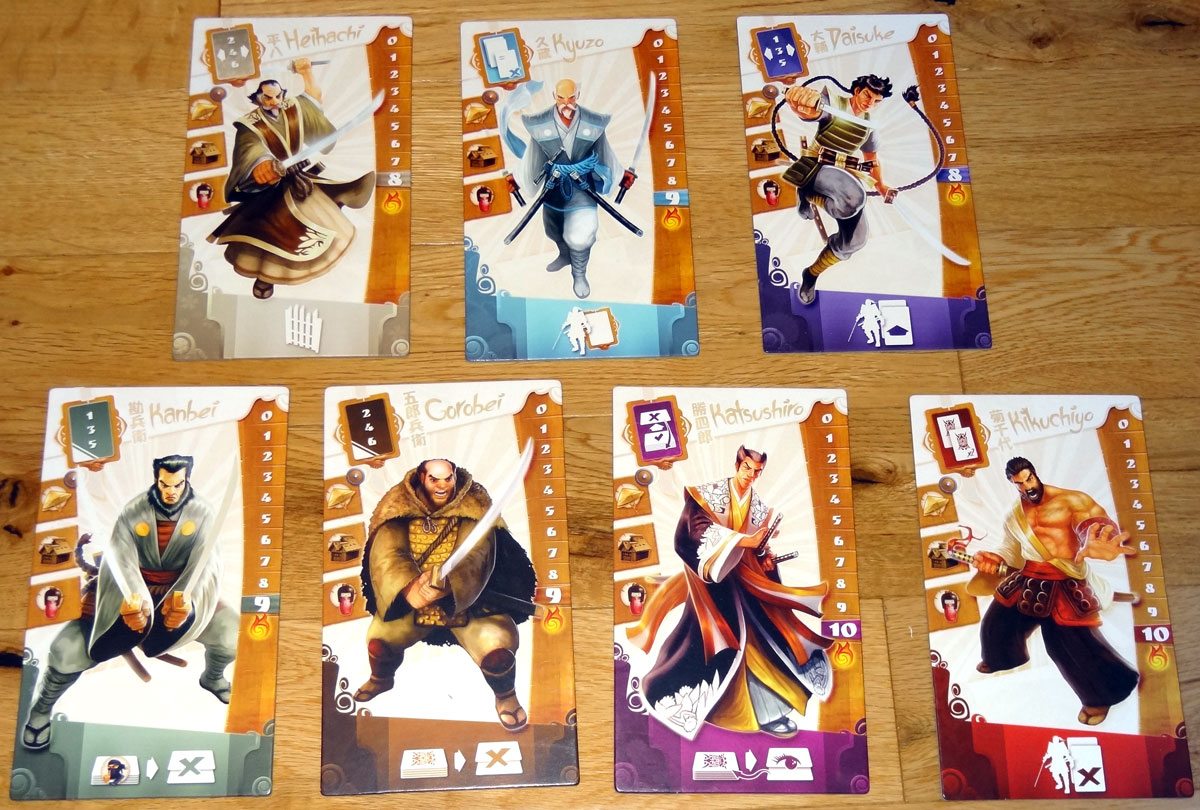
The cards and boards are all well designed so that the icons match up with things on the boards in a way that makes sense while you’re playing. The artwork, by Victor Pérez Corbella, is excellent–and everyone always loves seeing the animal versions of the samurai. The samurai are named after the characters from Seven Samurai.
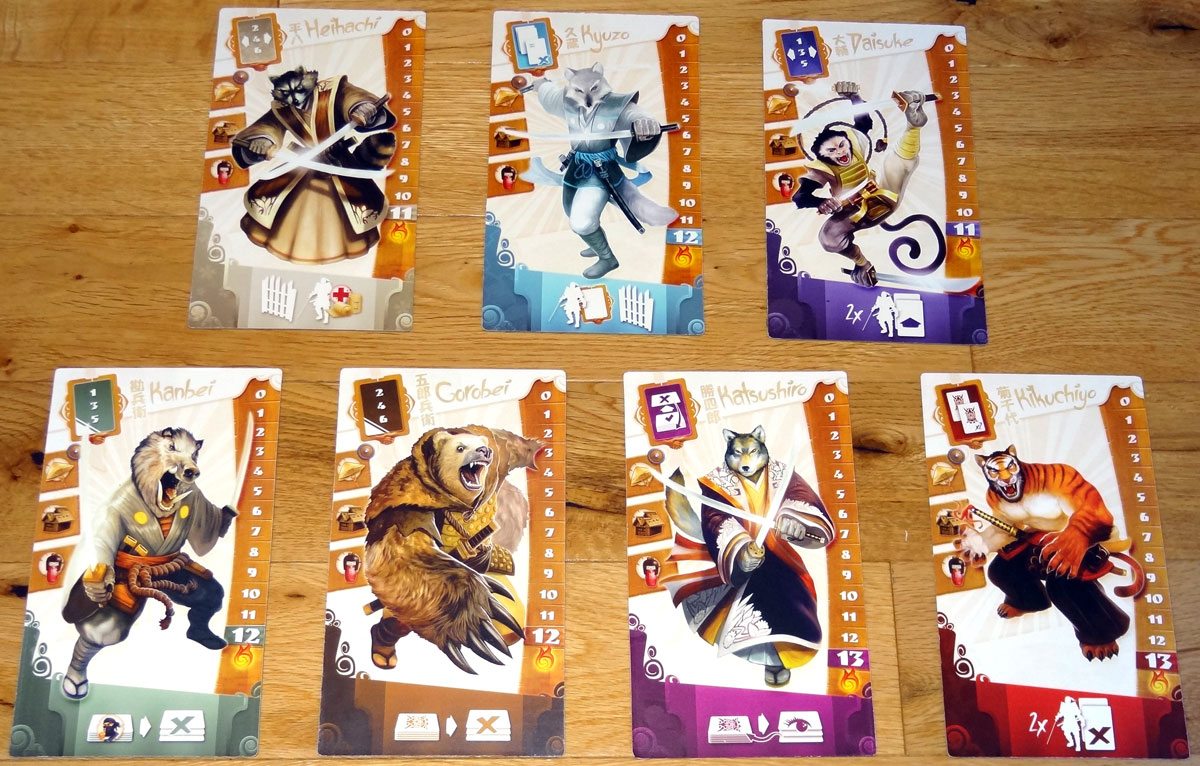
How to Play
The goal of the game is to protect the farmsteads and families in the village during three waves of raiders. If at least one farmstead and one family remain after the third round of play, then you win the game.

You begin by placing the village board in the center of the table, with the 3 family tokens and 6 farmstead tokens placed in their spots. You also begin with a number of barricades based on the number of players.
Remove the 5- and 6-value raiders from the deck and set them aside, and then shuffle the rest. Then count out raider cards equal to 7 times the number of players–this forms the deck, and the rest are put back into the box.

Each player gets a samurai board, a meeple, and the matching support token. The meeples are placed on the “0” space of each player’s battle track. A randomly chosen starting player gets the active player token.
On each turn, you must first apply the battle penalty, if any, and then carry out one action. Your first turn, there won’t be a battle penalty, but if you have any cards on the right side of your samurai board, you’ll look at the lower left corner of the most recent card. If there’s an icon there, it’s a penalty of some sort: destroy a barricade, take a wound, draw a card and give it to another player, and so on.
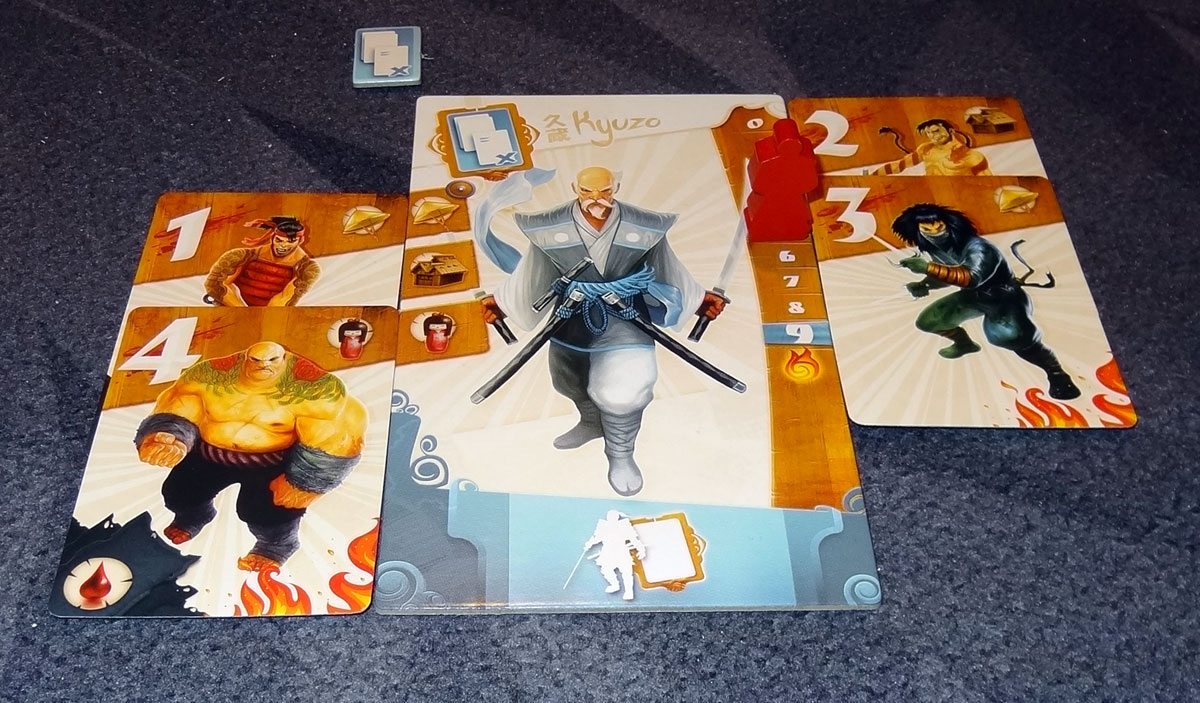
Then, you carry out your action: Fight, Support, or Pass.
To fight, you draw the top raider card, which is your current opponent. You have to Confront or Defend.
Confront means the card goes to the right of your samurai board. You then move your samurai meeple up your battle track equal to the value of the card. (The meeple should always show the current total of all the cards on the right of your board.) If you’re still below the maximum on your battle track, nothing else happens. If you hit your maximum exactly, it triggers your Kiai power. If you go beyond your maximum, you’ve been overcome, remove a barricade, and you must pass for the rest of the round.
Defend means the card is placed to the left of your samurai board. Some raider cards have icons on the top right that match up with the three icons on the left side of your samurai board: a hat, a farmhouse, or a doll (representing the families). You may “defend” only one card of each icon, and you signify that by placing the card next to your board so the icons line up. The value of the card doesn’t matter, and does not affect your battle track. The battle penalty icon on these cards are also ignored.
To support, you give your support token to another player. This will allow them to use your special ability during their next turn. (More on those later.) Then, instead of drawing and revealing a raider card as usual, you take the top raider card and put it into the invader stack next to the village board without looking at it.
To pass, you just tip your samurai meeple over, and you’ll sit out the rest of this round, as if you’re not playing. If you’ve exceeded the maximum on your battle track, then you must pass.
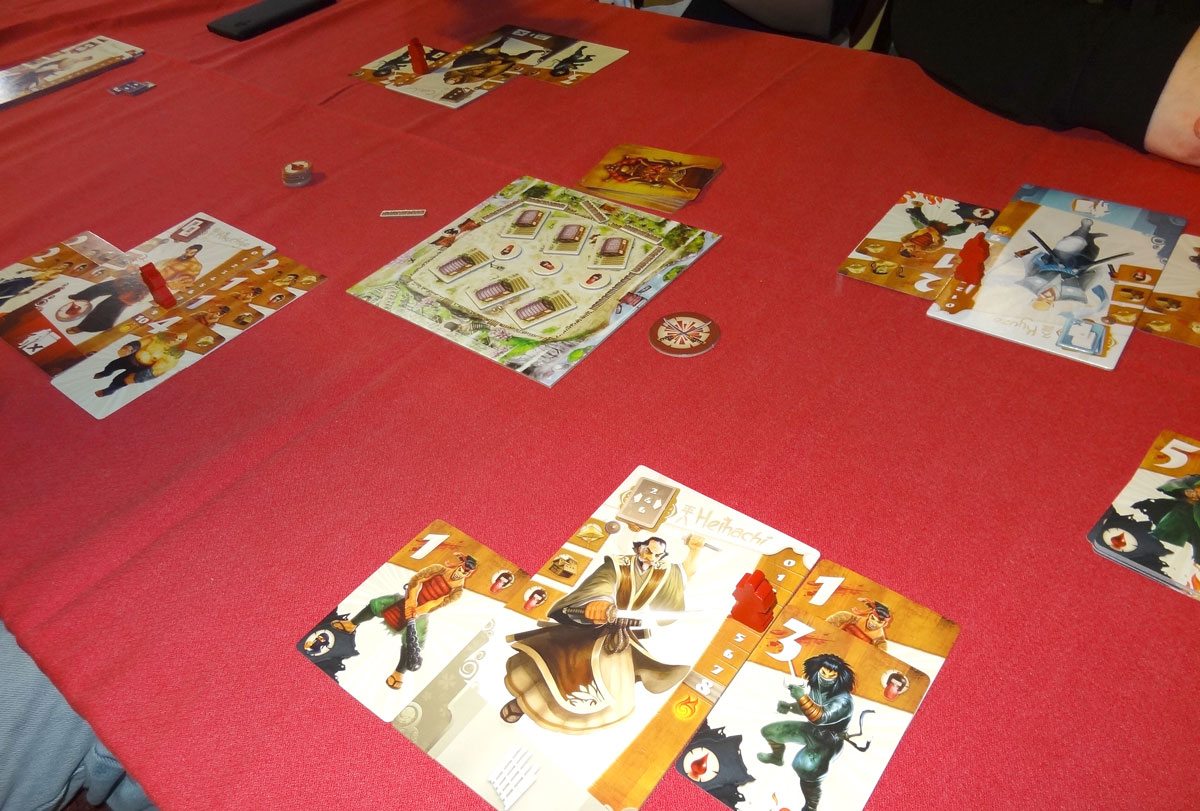
The round ends either when the last raider card is drawn and played, or when all players have passed. If all players passed, then any remaining raider cards are placed on top of the intruder stack.
At the end of the round a few things take place: first, any player who didn’t defend a card with a hat icon on the left side of the board takes a wound. Then, for each samurai that didn’t defend a card with a farm icon, one farmstead is removed from the village board. Finally, for each samurai that didn’t defend a card with a doll icon, one family token is removed from the village board. Then, each family token remaining in the village awards the team a bonus based on the icon on its back: heal one wound, add one barricade, or remove one intruder.
And then you deal with the intruders: flip over cards from the intruder stack one at a time. For each card that has flames in the lower right corner, remove one barricade from the village board. If there aren’t any barricades left, remove farmsteads.
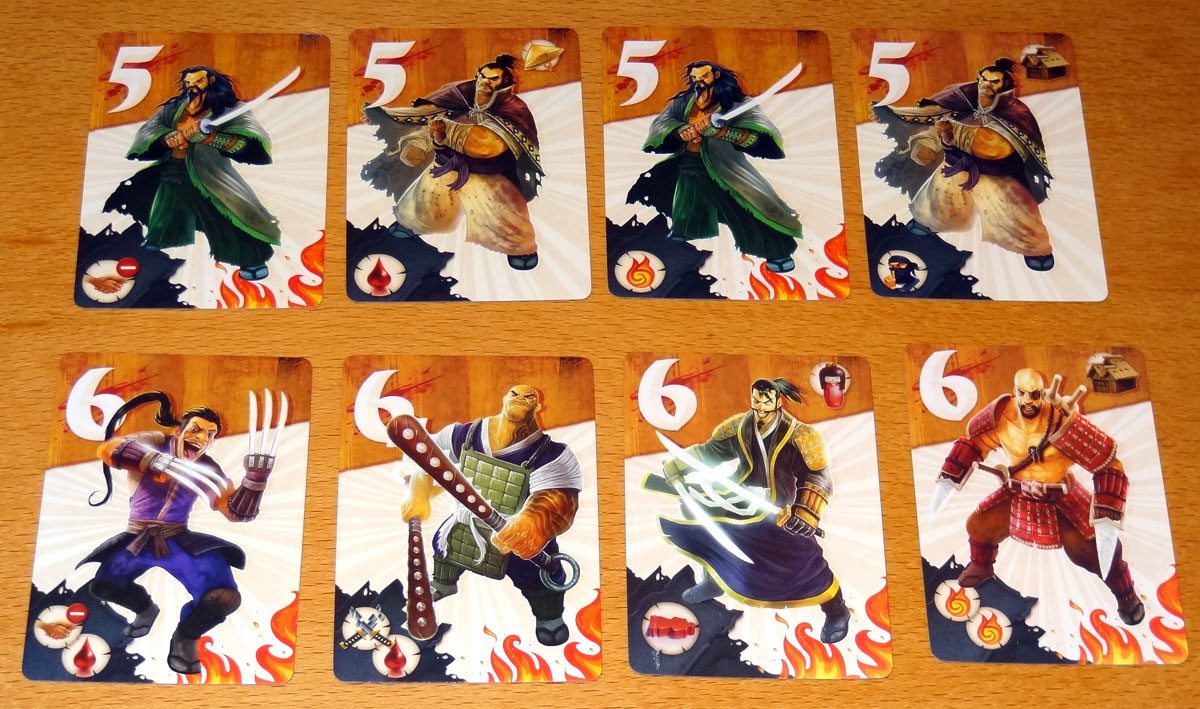
If there is still at least one farmstead and one family remaining, then you proceed to the next round. Reset everyone’s battle tracks, gather up all the cards, and then shuffle in one 5-value lieutenant per player. For the third round, you shuffle in one 6-value boss per player. If you survive the third round with at least one farmstead and one family remaining, you win the game. Otherwise, you lose.
Talents: Each samurai has a talent, which is shown at the top left corner of the board and matches the support token. You can always use your own talent during your turn; if another player gives you their support token, then you may also use that talent during your turn–but whether you use it or not, you must return the token at the end of your turn. There are various talents: ignore penalties on either odd or even cards, pass odd or even cards to a player next to you, fight a second time, discard a raider card if it matches one in your battle line, and draw a new card and put the first one back under the deck.
Kiai: Each samurai also has a special power called the kiai. If your meeple lands exactly on the last space of your battle track, then you may activate your kiai (shown at the bottom of your samurai board). You also then remove the oldest card from your battle line and discard it, adjusting your battle track to reflect the new total. So it is possible to activate the kiai multiple times in a round if you can get the right numbers into your battle line. The various kiai include building barricades, moving raider cards around, discarding raiders or intruders, and peeking ahead at the raider deck.
Animal Spirit: When you get a wound, you take a wound token. If you already have a wound token, you discard the wound and unleash your animal spirit and flip your board over (keeping any cards you currently have). The animal side of the board has a longer battle track and a more powerful kiai. As an animal, if you sustain two more wounds, then you are dead and the game ends in defeat.
There are some options for making the game easier or harder, mostly by adjusting the number of raider cards per player and the starting number of barricades. The farmstead tokens also have penalties on the back–on harder levels, each time you lose a farmstead, you also get an additional penalty. (Yes, the game kicks you while you’re down.)
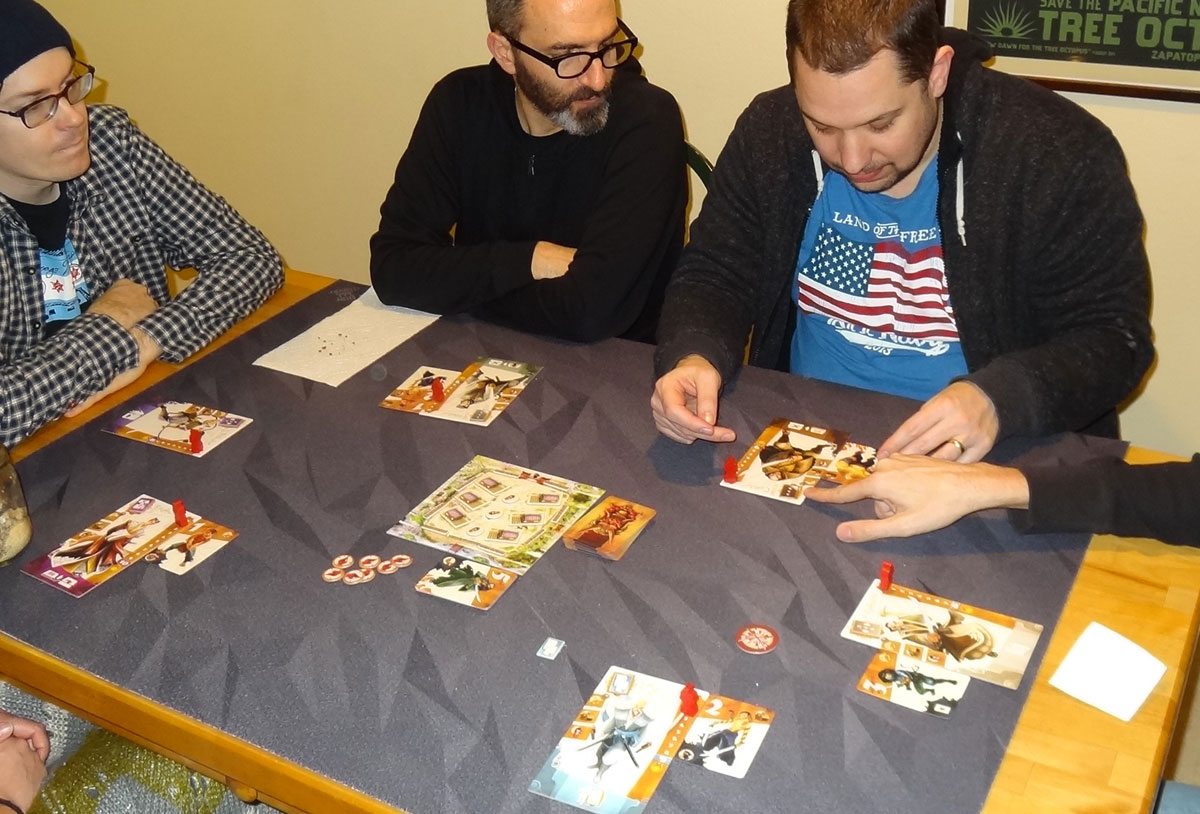
The Verdict
Antoine Bauza is a prolific game designer, and you may have played (or at least heard of) some of his games: 7 Wonders, Hanabi, Tokaido, Ghost Stories. That last one is also a cooperative game and it’s pretty brutal–I’ve played a handful of times and have never won, but I’m still trying. Samurai Spirit doesn’t feel quite as harsh, but maybe that’s because it’s over more quickly when you lose. I thought I’d gotten one win during GameStorm, but it turns out we were cheating because I got an important rule wrong. I’ve since had one victory in a three-player game at the normal difficulty level. I suppose it’s worth noting that, in the movie that inspired the game, most of the samurai are dead by the end.
First off, to enjoy Samurai Spirit, you need to like hard cooperative games. If you don’t enjoy games unless you win, then this is probably not the one for you. However, if (like me) you like a challenge and you don’t mind losing often, then keep reading.
There is a bit of luck involved, of course–the raiders are all shuffled together so you never know whether your next card is going to be one that you can handle easily. There’s even more variability when you’re playing with fewer players, because some cards will be set aside, meaning that the values of the raiders in the deck aren’t evenly distributed. You might get lucky and have lots of 1s and 2s, or you may end up with all of the 4s and get pounded.
There is also some strategy (or luck) in which characters are playing and the way they’re ordered around the table. For instance, the player who can pass even cards to adjacent players is even more useful when seated next to the player who can ignore battle penalties for even cards. I haven’t played enough to know if there’s an optimum arrangement, or the best samurai to use based on the number of players, but these factors do change the game. I like the mix of abilities, though, both in the talents and the kiai.
I do like that each turn you have a limited number of options, so it helps to keep the game from getting bogged down. (Although if you do have a lot of players, the game will take longer, both because there are more cards in the deck but also because there are that many more talents to take into account.) If you draw a card, you can only do so many thing with it–and sometimes the only thing you can do is put it into your battle line. But it’s important to consider, before you draw the card, whether it makes more sense for you to share your talent with somebody instead.
It’s always satisfying when you can hit your battle track number exactly and activate your kiai, but worrisome when you’re hovering near that number. Will the next card put you over, burning down an extra barricade and eliminating you for the rest of the round? I think the biggest single downside to the game is that when a player gets exhausted in this manner, they have to sit and wait for the round to end before they get to play again. In a 6- or 7-player game, that could be a while, but they don’t even get to leave and play something else, because they’re not completely eliminated from the game.
The balance between being overwhelmed on the battle track and taking wounds is an interesting one, too–they’re not directly related, so it’s not intuitive at first. You only take wounds either because of battle penalties, or because you didn’t play a “hat” icon on the defense side of your board during a round. Getting that second wound and flipping over to the animal side gives you a longer battle track and a more powerful kiai–but because the track is longer, it means you’ll activate your kiai less often. On the other hand, if you avoid wounds and stay with a shorter battle track, there’s a higher chance that you’ll get exhausted, and be totally useless to the team. Figuring out how many wounds you can afford to take is a tricky balance. I’ve played some games where nobody took wounds, but the village burned down in the meantime.
As a fully cooperative game, it is subject to the alpha player syndrome, where one player makes decisions for everyone. But in this case, since each player has to physically pick up a card and put it somewhere, at least they have the final say in where it goes–or whether they want to share their talent token. Still, it would be wise to rein in alpha players and encourage everyone to make their own decisions.
Overall, I’ve enjoyed Samurai Spirit and I look forward to playing some more and trying to beat it at harder levels or with varying number of players. It doesn’t seem as daunting as Ghost Stories, but may still be just as difficult to beat. What’s nice, though, is that it doesn’t take as long to play, win or lose, so even if the game destroys you, you’ll be done and back for another try pretty quickly.
Samurai Spirit is published by Fun Forge and distributed in the US by Passport Games. You can find it at your local game store, or order from Amazon.
Disclosure: Passport Games provided a review copy of this game.

